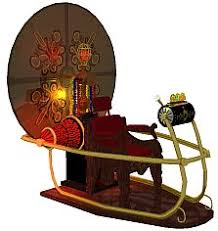Greenblatt claimed that the past is not actually "the past". Instead it is intermingled into the present. He believed that the past is everywhere we look. We cannot escape it.
 To me, it also meant that if we were to go back in time we would actually discover current issues. In World History at Northeast, my instructor, Mrs. Pam Floyd, always told us that history repeats because nothing is ever quite solved.
To me, it also meant that if we were to go back in time we would actually discover current issues. In World History at Northeast, my instructor, Mrs. Pam Floyd, always told us that history repeats because nothing is ever quite solved.
For example, the religious wars have always been going on and they will probably continue far into the future. Mrs. Floyd told us that if we ever find ourselves overwhelmed with the state of the world to just look into our history book. She said that it would not take long for us to find another culture in another time struggling with the same issues.
The best way for me to illustrate Greenblatt's claim is to provide a few examples. The following examples are quotes about the behavior of children. As you will see, some of the same issues keep coming up.
Today we see some of the same issues! Actually, books are still being written about "kids these days...". Take the following book for example:
Dr. Tim Elmore, a parenting expert, wrote this book to help us understand why our youth is slowly digressing. He believes that children these days are "ahead of schedule in so many categories, yet behind in others." By this he means that children/teens are biologically advanced, but their maturity levels are still behind.
So, Greenblatt knew what he was talking about! The past is never truly our past. Actually, fractions of the past are very similar to the present, as I have proven by using the "children these days..." example.
For example, the religious wars have always been going on and they will probably continue far into the future. Mrs. Floyd told us that if we ever find ourselves overwhelmed with the state of the world to just look into our history book. She said that it would not take long for us to find another culture in another time struggling with the same issues.
The best way for me to illustrate Greenblatt's claim is to provide a few examples. The following examples are quotes about the behavior of children. As you will see, some of the same issues keep coming up.
"The world is passing through troublous times. The young people of
today think of nothing but themselves. They have no reverence for
parents or old age. They are impatient of all restraint. They talk as
if they knew everything, and what passes for wisdom with us is
foolishness with them. As for the girls, they are forward, immodest
and unladylike in speech, behavior and dress."
-Peter the Hermit, 13th Century AD
"The children now love luxury. They have bad manners, contempt for
authority, they show disrespect to their elders.... They no longer
rise when elders enter the room. They contradict their parents,
chatter before company, gobble up dainties at the table, cross their
legs, and are tyrants over their teachers."
-Socrates, 5th century BC
"What is happening to our young people? They disrespect their elders,
they disobey their parents. They ignore the law.
They riot in the streets inflamed with wild notions.
Their morals are decaying. What is to become of them?"
-Plato,5th century BC
"I see no hope for the future of our people if they are dependent on
frivolous youth of today, for certainly all youth are reckless beyond
words... When I was young, we were taught to be discreet and
respectful of elders, but the present youth are exceedingly wise
[disrespectful] and impatient of restraint"
-Hesiod, 8th century BC
Today we see some of the same issues! Actually, books are still being written about "kids these days...". Take the following book for example:
Dr. Tim Elmore, a parenting expert, wrote this book to help us understand why our youth is slowly digressing. He believes that children these days are "ahead of schedule in so many categories, yet behind in others." By this he means that children/teens are biologically advanced, but their maturity levels are still behind.
So, Greenblatt knew what he was talking about! The past is never truly our past. Actually, fractions of the past are very similar to the present, as I have proven by using the "children these days..." example.


